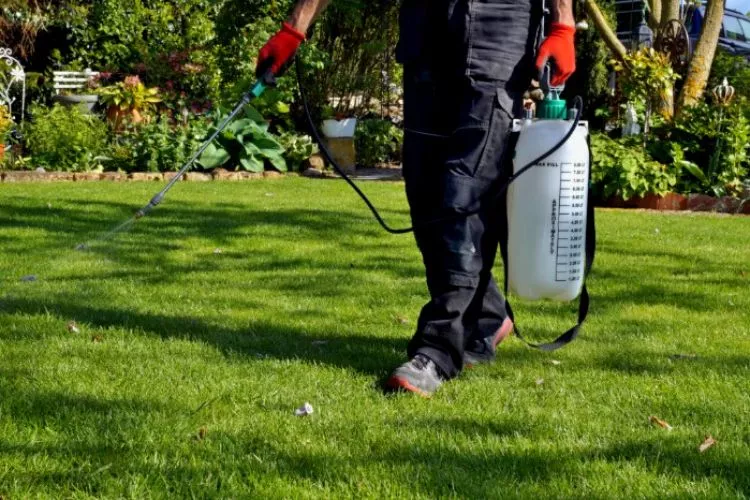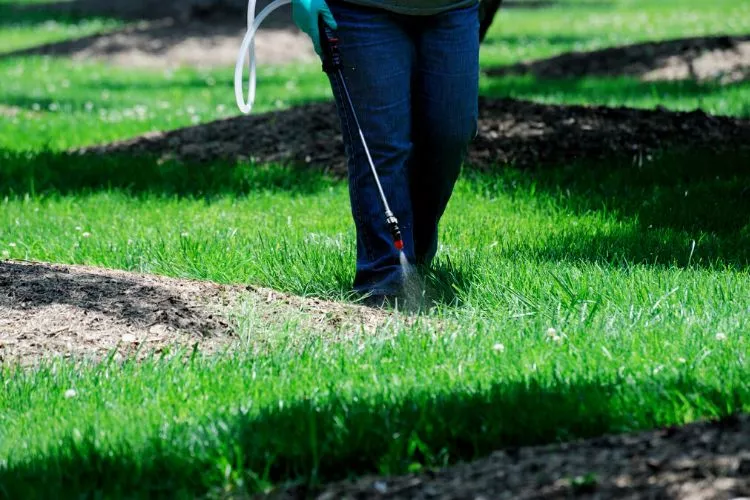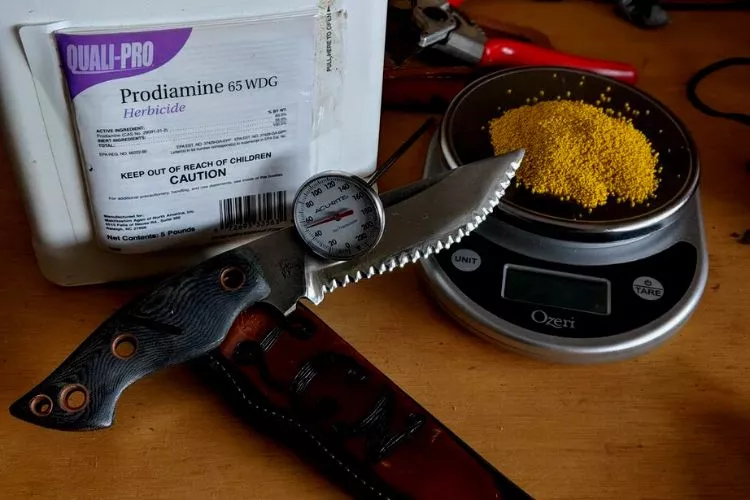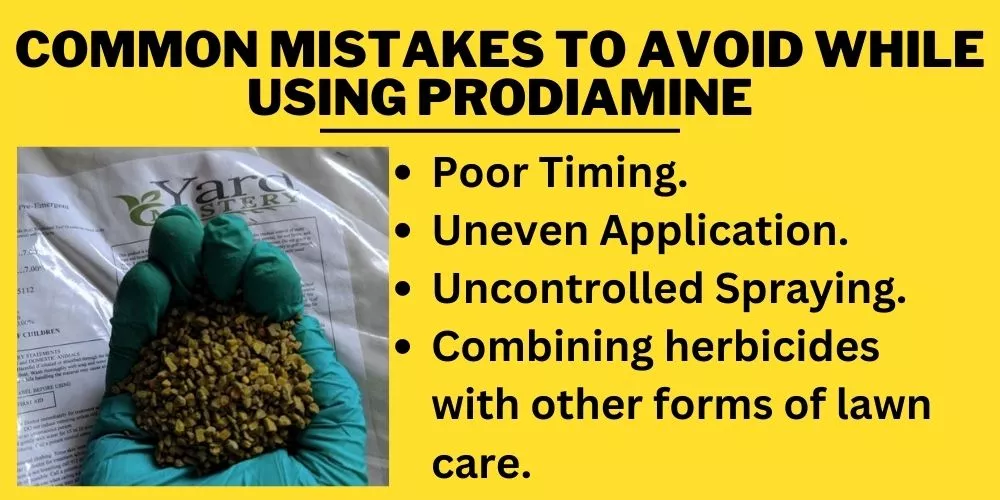Prodiamine, a.k.a. Barricade, is an active ingredient used in certain herbicides that have been formulated specifically to stop weeds from germinating and therefore growing.
It can be safely used on turf/grass areas to help eliminate weeds without causing any harm to the grass. But do you know how long does prodiamine last?
Well, prodiamine can be effective for up to 6-8 months from the application date and this herbicide has a shelf life of 3 years if stored correctly.
It is hazardous to humans and animals, so it’s advised to follow the application instructions to avoid any kind of harm.
Prodiamine is extremely effective against sedges, annual grasses such as annual bluegrass, spurge, witchgrass, henbit, knotweed, chickweed, foxtail, and goosegrass 30+ other species of problematic broadleaf weeds.

Table of Contents
How Does Prodiamine Work?
In simple terms, Prodiamine works by stopping certain weeds from germinating. If germination doesn’t occur, the root system won’t even begin to form.
The root system is the driving force behind all plant life, including weeds and grasses.
The roots are responsible for searching for nutrients and water and becoming the anchor, which gives structure to each blade of grass or weed.
That’s why this particular product is so effective. It has been formulated to prevent the problem of weeds and keep the desired greenery intact. You could compare the process to that of birth control.

There is a large range of good quality products out there, but after testing quite a few, we have found that these products, in particular, are extremely effective:
- Prodiamine 65 WDG – 5lbs hybrid liquid/granulated form
- Prodiamine Granular Pre Emergent Herbicide – 45 lbs granular
- Prodiamine Quali-Pro – 4 Liter liquid form
How long does prodiamine last?
In general, Prodiamine will last anywhere from 6-8 months. However, a few factors can prevent it from lasting this length of time.
Firstly, the weather can play a big role in the lifetime of each application. If the area that the herbicide is applied to is saturated by rain, it won’t be able to sink properly, which makes it useless.
It’s much more beneficial to use it at least 24 hours after rainfall. Drought stress from extreme heat may cause minor issues also.
Additionally, some grasses and/or weeds can be more stubborn to eradicate before their germinated forms can even be treated.
Lastly, the treated area could be too large for the amount you are using. This can also reduce the lifetime of the amount being applied.
When to Apply Prodiamine 65 WDG?
The best time to use Prodiamine 65 WDG is early in the spring as the ground temperatures begin to rise.
Depending on your geographic location, winters are generally too cold to apply these types of treatments as they activate at around 55°F (13°C).

It is possible in some areas, but it’s more common for winters to average lower temperatures than the required 55°F (13°C).
So, in the Northern hemisphere, you’d apply this product around mid-March to help control the species of weeds/problem grasses that appear in the Summertime.
If you are trying to eradicate those stubborn winter/fall type grasses and/or weeds such as bluegrass and prickly lettuce, it’s best to apply Prodiamine 65 WDG during August & November.
Of course, the months and seasons will be the opposite if you are located in the Southern hemisphere.
The most important aspect to keep in mind is the temperature. You can measure the ground temperature by simply sticking a thermometer at least 2 inches into the soil and taking a reading.
Does Prodiamine Need To Be Watered In?
The most effective way to distribute Prodiamine is diluting it with water after the initial application. Regardless of their form or characteristic, they can be granular, liquid, synthetic or organic.
These herbicides need a certain amount of water to produce the chemical barrier just above the surface.
The barrier formed is effectively what prevents the seeds from germinating. The product requires around half an inch of water coverage once applied to create this barrier.
Using too much water will make the herbicide soak deeper than the layer where the seed germinates.
This will cause the herbicide to become too diluted and won’t allow it to be effective. On the other hand, not using enough water will leave a heap of product just sitting on the area of application without being able to be activated.
As a result, the product will eventually wash away but become less potent the longer it sits unused. It’s best to wait at least 24 hours after any rainfall before applying.
It’s also ideal to have several days without rain following application so the process can be closely controlled and monitored.
How to Apply Prodiamine?
Applying Prodiamine is a little like using roundup. Let’s look at what the process involves in a step-by-step form.
- Wait at least 24 hours after a day of rain. The ground must be dry, so the product doesn’t get washed away before becoming effective.
- Measure the coverage area to determine the amount that you need to use. Keep in mind that different species of weeds and grasses require different strengths of the herbicide. E.g., St. Augustine grass requires 0.28-0.55 oz per 1,000 sq ft. Kentucky Bluegrass requires 0.185-0.55 oz per sq ft. If you’re unsure, measure: Length X Width Eg: 40m X 25m = 1000 square feet.
- Fill either a hand pump or backpack sprayer with ¼ of the required amount of water (according to the user instructions), then add the measured amount of the herbicide. Shake the mixture until the herbicide has been diluted, then add the rest of the water. For smaller, home jobs, you’d probably need around 1 gallon (3.8 Liters) of water. For larger jobs that may require a larger spray rig, you’d need around 20 gallons (76 Liters) of water. Additionally, thicker grasses and weeds may need double the amount of water to allow the herbicide to soak into the ground.
- Ensure that the treated areas dry completely before humans and/or pets enter the area again. Depending on the product, they will generally control the grasses and weeds for upto 6 months. Some can last a couple of months longer.
Common Mistakes to Avoid While Using Prodiamine
Using this type of herbicide is generally pretty straightforward. However, gardeners tend to make some common mistakes whilst using these products.
Some of them can be disastrous if not corrected as soon as they arise. Let’s look at the problems that can occur whilst use Prodiamine.

Poor Timing
Quite often, it’s the small details that can ruin all of the hard work. In this case, timing is what can see a whole process come undone.
Prodiamine should be used 2 weeks before temperatures rise to 55°F in the spring to eradicate summer weeds. It’s tricky to judge when the temperature will reach that high, but the product won’t work if not timed right.
Furthermore, it should also be used 2 weeks before the soil temperature cools to below 70°F in the fall. (For removing winter weeds) Those 2 weeks are important to ensure the product is ready to go before those specific types of weeds germinate.
Once they germinate or establish themselves, it’s too late, and the product won’t have any effect.
Uneven Application
If the product is not sprayed evenly, the risk of weeds forming and multiplying is much higher. You can add a branded dye into your herbicide solution to assist with even distribution.
The dye is usually a dark green/blue color and, once applied, will give a visual indication of the areas you have treated to prevent going over them again or missing spots.
Uncontrolled Spraying
Much like uneven application, too little or too much herbicide can cause possible damage to your lawn. Applying too much in a certain area can disrupt the ability of welcomed grasses to form.
As a result, the area may become patchy with soil and grass. When not enough herbicide is applied, the product won’t have an effect and will allow weeds and unwanted grass species to take over.
Combining herbicides with other forms of lawn care
Applying products such as prodiamine should be completed as a stand-alone process. It should never be used simultaneously with other processes such as aeration, fertilization, seeding, etc.
It will either ruin the progress of those processes mentioned or stop the herbicide from having an effect. It is recommended to wait at least a year after using herbicides before engaging in tasks such as those mentioned.
Frequently Asked Questions (fAQs)
How long after Prodiamine can I mow?
It’s recommended to stop mowing at least 2 days before application and wait at least 2 days after application to resume mowing the treated grass. This will allow the area to soak in the herbicide and reduce any possible stress caused by the product.
Does Prodiamine prevent crabgrass?
Yes, Prodiamine is effective against several species of annual summer grasses, including crabgrass. Additionally, it helps control annual bluegrass, goosegrass, spurge, chickweed, and broadleaf weeds.
Can You Over-Apply Prodiamine?
It is possible to over-apply Prodiamine, but it won’t cause much harm to the treated area. It will just become less effective. Over applying causes microbes in the lawn to take it in too fast and make it expand at an undesirable percentage. So technically, too much of this herbicide leaves you with a lesser amount. The remains will wash away as it rains.
Conclusion:
Prodiamine is a great product due to its ease of use and, more surprisingly, its longevity. If applied correctly, your lawns and decorative areas can stay clean of targeted weeds and grasses for at least 6 months.
The beauty of it is that it only needs to be applied once. Amazing stuff! We hope that you have found this article helpful in your journey toward a pristine lawn. Thanks for tuning in, and as always, happy growing!


